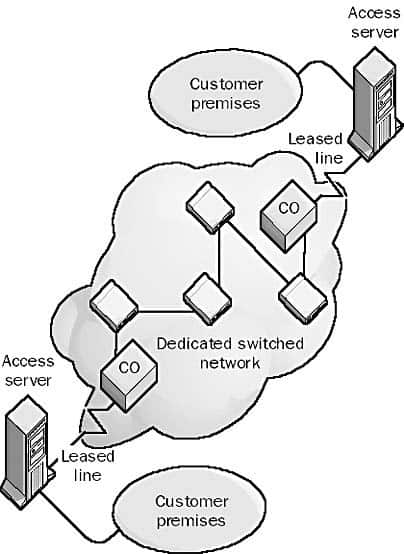Definition of Leased Line in Network Encyclopedia.
What is Leased Line?
Leased Libe, also called a dedicated line, is a telecommunications service provided to businesses by telcos and long distance carriers that provides a permanent direct connection between two geographically separate local area networks (LANs).

Leased lines are dedicated circuits that the telco reserves for the exclusive use of the customer. They are permanently available, always active, and secure, and they have consistent quality of service (QoS) and a flat monthly fee. However, they are very expensive compared to dial-up lines, and businesses rarely use their full bandwidth capabilities except in short bursts.
Leased lines are a form of point-to-point connection. Your LAN is connected by bridges, routers, modems, and terminal adapters to the telco’s central office (CO), which sets up dedicated switches to connect you to the destination LAN. The presence of dedicated switches is what makes leased lines so expensive. You would use a leased line to connect a Microsoft Exchange server to the Internet, for example. Since the leased line is always on, there is no connection delay when users try to access the server for their e-mail.
Leased lines are available in 56 Kbps, T1, T3, and higher speeds. They are used mainly for connecting customer premises to the telco CO. The charge for a leased line is based on both bandwidth and distance; leased lines are usually leased for a base monthly cost, and sometimes incur an extra monthly charge proportional to the traffic carried on the line.

Different Applications of Leased Lines
Leased lines are used to build up private networks, private telephone networks (by interconnecting PBXs) or access the internet or a partner network (extranet).
Here is a review of the leased-line applications in network designs over time:
- Site to site data connectivity: Terminating a leased line with two routers can extend network capabilities across sites.
- Site to site PBX connectivity: Terminating a leased line with two PBX allowed customers to by-pass PSTN for inter-site telephony. This allowed the customers to manage their own dial plan (and to use short extensions for internal telephone number) as well as to make significant savings if enough voice traffic was carried across the line (especially when the savings on the telephone bill exceeded the fixed cost of the leased line).
- Site to network connectivity: As demand grew on data network telcos started to build more advanced networks using packet switching on top of their infrastructure. Thus, a number of telecommunication companies added ATM, Frame-relay or ISDN offerings to their services portfolio. Leased lines were used to connect the customer site to the telco network access point.
- International private leased circuit: An international private leased circuit (IPLC) functions as a point-to-point private line. IPLCs are usually time-division multiplexing (TDM) circuits that utilize the same circuit amongst many customers. The nature of TDM requires the use of a CSU/DSU and a router. Usually, the router will include the CSU/DSU.
Then came the Internet (in the mid-1990s) and since then the most common application for leased line is to connect a customer to its ISP point of presence. With the changes that the Internet brought in the networking world other technologies were developed to propose alternatives to frame-relay or ATM networks such as VPNs (hardware and software) and MPLS networks (that are in effect an upgrade to TCP/IP of existing ATM/frame-relay infrastructures).
Leased Line alternatives
Leased lines are more expensive than alternative connectivity services including (ADSL, SDSL, etc.) because they are reserved exclusively to the leaseholder. Some internet service providers have therefore developed alternative products that aim to deliver leased-line type services (carrier Ethernet-based, zero contention, guaranteed availability), with more moderate bandwidth, over the standard UK national broadband network. While a leased line is full-duplex, most leased line alternatives provide only half-duplex or in many cases asymmetrical service.
NOTE
The opposite of a leased or dedicated line is a dial-up line or switched line.